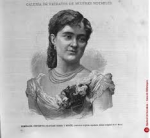Clotilde Cerdá i Bosch
Biography
Clotilde Cerdá i Bosch was a concert harpist, baptized with the pseudonym "Esmeralda Cervantes" by Victor Hugo; Esmeralda after the heroine of his Hunchback of Notre Dame and Cervantes after the 11-year-old artist first played in public during funeral services held in Vienna in honour of the author of Don Quixote. Clotilde was born into an upper middle class family, the heiress to wealthy landowners who gave her a liberal arts education. Although her mother sent her to Rome to study painting, she had opted for music since she was a girl, becoming a child prodigy at playing the harp.
After finishing her studies in Rome, Paris and Vienna, the harp virtuoso Clotilde was called for and acclaimed by the general public and toured the world as a concert musician with great success. She captivated audiences in the concert halls of Second Empire Paris and continued her tour of Europe playing for the major royal houses such as the English, Württemberg, Dutch, Greek and Belgian royal families.
At fifteen years of age, Clotilde accepted a hundred contracts in South and North America and went on an artistic tour that lasted about two years. On the island of Cuba, she found herself in the heat of the conflicts that were beginning, so she did not want to accept the proceeds and gave them to charity. In Mexico, after playing President Porfirio Díaz, he said to her: “You are wonderful. Ask what you want and I shall grant it to you.” Clotilde asked for a prisoner to be pardoned, which Porfirio Díaz did.
A wanderer in the arts and indefatigable traveller, she returned to Europe. Among other successful performances, in Rome she was praised by Franz Liszt. And once again she travelled to America. In Brazil, she was invited by Emperor Pedro II to officiate in the opening of the international bridge between Brazil and Uruguay, which is why he gave it her name. She was given valuable jewels as a gift at one of her concerts in Buenos Aires and portrayed emerging from a crown of clouds playing the harp. Back in Barcelona and Paris once again, she directed a magazine called "The Angel in the House (El Ángel del Hogar)", another called "The Pole Star (La Estrella Polar)", and she published her "History of the Harp”. Nevertheless, she left again, this time to Constantinople as a teacher of the harp to the women of the harem of the Sultan of Turkey, who were regarded as the best in the world at playing stringed instruments.
Chronology
1873 Debut at the Imperial Theatre in Vienna.
1875 Travels to South and North America with great success. She plays in Buenos Aires at the court of the Emperor of Brazil, and in Mexico City.
1881 Joins the Lealtad Masonic Lodge of Barcelona.
1885 Back in Spain, she launches a high-level female educational institution, the Academy for the Enlightenment of Women, with Dolors Aleu i Riera.
1887 Travels to Constantinople as teacher of the harp for the harem of the Sultan of the Ottoman Empire. In Turkey, she marries a German-Brazilian and her career ends.
Sources of Information
-
Fabián Estapé Rodriguez. Biographical Summary of Ildefonso Cerdá Sunyer (Esquema Biográfico de Ildefonso Cerdá Sunyer). http://www.racmyp.es/docs/anales/A72/A72-17.pdf
-
The daughter of Cerdá. Another Universal Barcelona Lady: Esmeralda Cervantes. (La hija de Cerdá. Otra Barcelonesa Universal: Esmeralda Cervantes.) La Vanguardia Española, 31 May, 1964. http://hemeroteca.lavanguardia.com/preview/1884/12/09/pagina-47/32680174/pdf.html?search=esmeralda cervantes
-
Isabel Segura. The travels of Clotilde Cerdá i Bosch (Els viatges de Clotilde Cerdá i Bosch). Tres i Quatre, Barcelona, 2013.
Photo:
- Diputació de Barcelona - Xarxa de Biblioteques. Public Domain (copyright term of life of the author plus 100 years or less). Wikimedia Commons. http://commons.wikimedia.org/wiki/File:Esmeralda_Cervantes.png.




